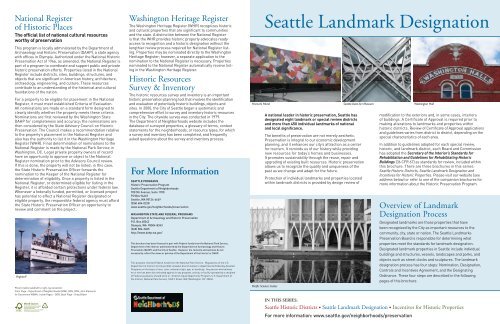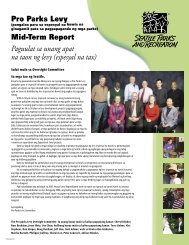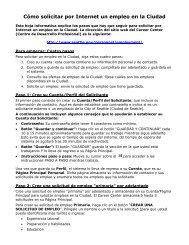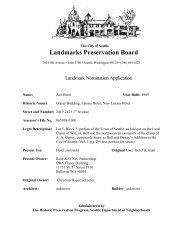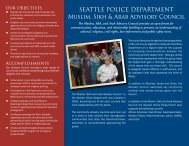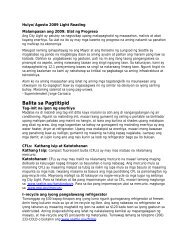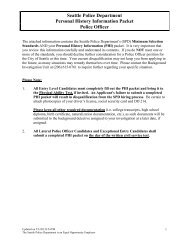Seattle Landmark Designation - City of Seattle
Seattle Landmark Designation - City of Seattle
Seattle Landmark Designation - City of Seattle
Create successful ePaper yourself
Turn your PDF publications into a flip-book with our unique Google optimized e-Paper software.
National Register<br />
<strong>of</strong> Historic Places<br />
The <strong>of</strong>ficial list <strong>of</strong> national cultural resources<br />
worthy <strong>of</strong> preservation<br />
This program is locally administered by the Department <strong>of</strong><br />
Archaeology and Historic Preservation (DAHP), a state agency<br />
with <strong>of</strong>fices in Olympia. Authorized under the National Historic<br />
Preservation Act <strong>of</strong> 1966, as amended, the National Register is<br />
part <strong>of</strong> a program to coordinate and support public and private<br />
historic preservation efforts. Properties listed in the National<br />
Register include districts, sites, buildings, structures, and<br />
objects that are significant in American history, architecture,<br />
archaeology, engineering, and culture. These resources<br />
contribute to an understanding <strong>of</strong> the historical and cultural<br />
foundations <strong>of</strong> the nation.<br />
For a property to be eligible for placement in the National<br />
Register, it must meet established Criteria <strong>of</strong> Evaluation.<br />
All nominations are made on a standard form designed to<br />
clearly identify whether the property meets these criteria.<br />
Nominations are first reviewed by the Washington State<br />
DAHP for completeness and accuracy; the nominations are<br />
then considered by the State Advisory Council on Historic<br />
Preservation. The Council makes a recommendation relative<br />
to the property’s placement in the National Register and<br />
also has the authority to list it in the Washington Heritage<br />
Register (WHR). Final determination <strong>of</strong> nominations to the<br />
National Register is made by the National Park Service in<br />
Washington, DC. Legal private property owners <strong>of</strong> record<br />
have an opportunity to approve or object to the National<br />
Register nomination prior to the Advisory Council review.<br />
If this is done, the property will not be listed; in this case,<br />
the State Historic Preservation Officer forwards the<br />
nomination to the Keeper <strong>of</strong> the National Register for<br />
determination <strong>of</strong> eligibility. Once a property is listed in the<br />
National Register, or determined eligible for listing in the<br />
Register, it is afforded certain protections under federal law.<br />
Whenever a federally funded, permitted, or licensed project<br />
has potential to affect a National Register designated or<br />
eligible property, the responsible federal agency must afford<br />
the State Historic Preservation Officer an opportunity to<br />
review and comment on the project.<br />
Virginia V<br />
Photo Credits listed left to right, top to bottom.<br />
Front Page – Department <strong>of</strong> Neighborhoods (DON), DON, DON, John Staments<br />
for Docomomo WEWA., Inside Pages – DON, Back Page – Greg Gilbert<br />
Cert no. SCS-COC-002790<br />
50%<br />
Washington Heritage Register<br />
The Washington Heritage Register (WHR) recognizes historic<br />
and cultural properties that are significant to communities<br />
and the state. A distinction between the National Register<br />
is that the WHR provides historic property advocates ready<br />
access to recognition and a historic designation without the<br />
lengthier review process required for National Register listing.<br />
Properties may be nominated directly to the Washington<br />
Heritage Register; however, a separate application to the<br />
nomination to the National Register is necessary. Properties<br />
nominated to the National Register automatically receive listing<br />
in the Washington Heritage Register.<br />
Historic Resources<br />
Survey & Inventory<br />
The historic resources survey and inventory is an important<br />
historic preservation planning tool that involves the identification<br />
and evaluation <strong>of</strong> potentially historic buildings, objects and<br />
sites. In 2000, the <strong>City</strong> <strong>of</strong> <strong>Seattle</strong> began a systematic and<br />
comprehensive effort to survey and inventory historic resources<br />
in the <strong>City</strong>. The citywide survey was conducted in 1979.<br />
The Department <strong>of</strong> Neighborhoods website includes the<br />
database <strong>of</strong> surveyed properties, a glossary <strong>of</strong> terms, context<br />
statements for the neighborhoods, or resource types, for which<br />
a survey and inventory has been completed, and frequently<br />
asked questions about the survey and inventory process.<br />
For More Information<br />
SEATTLE PROGRAMS<br />
Historic Preservation Program<br />
<strong>Seattle</strong> Department <strong>of</strong> Neighborhoods<br />
700 5th Avenue, Suite 1700<br />
PO Box 94649<br />
<strong>Seattle</strong>, WA 98124-4649<br />
(206) 684-0228<br />
www.seattle.gov/neighborhoods/preservation<br />
WASHINGTON STATE AND FEDERAL PROGRAMS<br />
Department <strong>of</strong> Archaeology and Historic Preservation<br />
P.O. Box 48343<br />
Olympia, WA 98504-8343<br />
(360) 586-3065<br />
http://www.dahp.wa.gov/<br />
This brochure has been financed in part with Federal funds from the National Park Service,<br />
Department <strong>of</strong> the Interior administered by the Department <strong>of</strong> Archaeology and Historic<br />
Prservation (DAHP), and the <strong>City</strong> <strong>of</strong> <strong>Seattle</strong>. However, the contents and opinions do not<br />
necessarily reflect the views or policies <strong>of</strong> the Department <strong>of</strong> the Interior or DAHP.<br />
This program received Federal funds from the National Park Service. Regulations <strong>of</strong> the U.S.<br />
Department <strong>of</strong> Interior strictly prohibit unlawful discrimination in departmental Federally Assisted<br />
Programs on the basis <strong>of</strong> race, color, national origin, age, or handicap. Any person who believes<br />
he or she has been discriminated against in any program, activity, or facility operated by a recipient<br />
<strong>of</strong> Federal assistance should write to: Director, Equal Opportunity Program, U.S. Department <strong>of</strong><br />
the Interior, National Park Service, 1849 C Street, NW, Washington, DC 20240.<br />
<strong>Seattle</strong> <strong>Landmark</strong> <strong>Designation</strong><br />
Horiuchi Mural <strong>Seattle</strong> Asian Art Museum Washington Hall<br />
A national leader in historic preservation, <strong>Seattle</strong> has<br />
designated eight landmark or special review districts<br />
and more than 450 individual landmarks <strong>of</strong> national<br />
and local significance.<br />
The benefits <strong>of</strong> preservation are not merely aesthetic.<br />
Preservation is integral to our economic development<br />
planning, and it enhances our city’s attraction as a center<br />
for tourism. It reminds us <strong>of</strong> our history while providing<br />
new resources for today’s homes and businesses.<br />
It promotes sustainability through the reuse, repair and<br />
upgrading <strong>of</strong> existing built resources. Historic preservation<br />
allows us to recognize the quality and uniqueness <strong>of</strong> the<br />
past as we change and adapt for the future.<br />
Protection <strong>of</strong> individual landmarks and properties located<br />
within landmark districts is provided by design review <strong>of</strong><br />
Pacific Science Center<br />
modification to the exteriors and, in some cases, interiors<br />
<strong>of</strong> buildings. A Certificate <strong>of</strong> Approval is required prior to<br />
making alterations to landmarks and properties within<br />
historic districts. Review <strong>of</strong> Certificate <strong>of</strong> Approval applications<br />
and guidelines varies from district to district, depending on the<br />
special characteristics <strong>of</strong> each area.<br />
In addition to guidelines adopted for each special review,<br />
historic, and landmark district, each Board and Commission<br />
has adopted the Secretary <strong>of</strong> the Interior’s Standards for<br />
Rehabilitation and Guidelines for Rehabilitating Historic<br />
Buildings (36 CFR 67) as standards for review, included within<br />
this brochure. There are three brochures in this series:<br />
<strong>Seattle</strong> Historic Districts, <strong>Seattle</strong> <strong>Landmark</strong> <strong>Designation</strong> and<br />
Incentives for Historic Properties. Please visit our website (see<br />
address below) or refer to one <strong>of</strong> the companion brochures for<br />
more information about the Historic Preservation Program.<br />
Overview <strong>of</strong> <strong>Landmark</strong><br />
<strong>Designation</strong> Process<br />
Designated landmarks are those properties that have<br />
been recognized by the <strong>City</strong> as important resources to the<br />
community, city, state or nation. The <strong>Seattle</strong> <strong>Landmark</strong>s<br />
Preservation Board is responsible for determining what<br />
properties meet the standards for landmark designation.<br />
Designated landmark properties in <strong>Seattle</strong> include individual<br />
buildings and structures, vessels, landscapes and parks, and<br />
objects such as street clocks and sculptures. The landmark<br />
designation process has four steps: Nomination, <strong>Designation</strong>,<br />
Controls and Incentives Agreement, and the Designating<br />
Ordinance. These four steps are described in the following<br />
pages <strong>of</strong> this brochure.<br />
IN THIS SERIES:<br />
<strong>Seattle</strong> Historic Districts • <strong>Seattle</strong> <strong>Landmark</strong> <strong>Designation</strong> • Incentives for Historic Properties<br />
For more information: www.seattle.gov/neighborhoods/preservation<br />
<strong>Landmark</strong>_brochure_f5.indd 1<br />
10/13/11 3:46 PM
Nomination<br />
A nomination for <strong>City</strong> <strong>of</strong> <strong>Seattle</strong> landmark status may be<br />
submitted by any person or group. A standard nomination<br />
application, available from the Historic Preservation Program,<br />
must be completed and reviewed by the <strong>City</strong> Historic<br />
Preservation Officer for adequacy. Guidelines for nomination<br />
preparation are also available. Once the submitted information<br />
has been determined to be adequate, the nomination will<br />
be scheduled for consideration by the <strong>Seattle</strong> <strong>Landmark</strong>s<br />
Preservation Board at a public meeting.<br />
At the public meeting, the Board may approve the nomination<br />
in whole or in part, based on the designation standards.<br />
Another public meeting is scheduled for designation 30<br />
to 60 days from the date <strong>of</strong> approval <strong>of</strong> the nomination.<br />
Once a building is nominated, any alterations to the features<br />
that were approved for nomination require a Certificate<br />
<strong>of</strong> Approval. If the Board does not approve a nomination,<br />
the proceedings terminate and the property cannot be<br />
considered for nomination for five years, except at the<br />
request <strong>of</strong> the owner.<br />
Norton Building<br />
<strong>Designation</strong><br />
In order to be designated, the building, object, or site must<br />
be at least 25 years old and must meet at least one <strong>of</strong> the six<br />
standards for designation outlined in the <strong>Seattle</strong> <strong>Landmark</strong>s<br />
Preservation Ordinance (SMC 25.12.350):<br />
• It is the location <strong>of</strong>, or is associated in a significant<br />
way with, an historic event with a significant effect<br />
upon the community, <strong>City</strong>, state, or nation; or<br />
• It is associated in a significant way with the life <strong>of</strong> a<br />
person important in the history <strong>of</strong> the <strong>City</strong>, state, or<br />
nation; or<br />
• It is associated in a significant way with a significant<br />
aspect <strong>of</strong> the cultural, political, or economic heritage<br />
<strong>of</strong> the community, <strong>City</strong>, state or nation; or<br />
• It embodies the distinctive visible characteristics <strong>of</strong><br />
an architectural style, or period, or <strong>of</strong> a method <strong>of</strong><br />
construction; or<br />
• It is an outstanding work <strong>of</strong> a designer or builder; or<br />
• Because <strong>of</strong> its prominence <strong>of</strong> spatial location,<br />
contrasts <strong>of</strong> siting, age, or scale, it is an easily<br />
identifiable visual feature <strong>of</strong> its neighborhood or<br />
the city and contributes to the distinctive quality or<br />
identity <strong>of</strong> such neighborhood or the <strong>City</strong>.<br />
In addition to meeting at least one <strong>of</strong> the above standards,<br />
the object, site, or building must also possess integrity or the<br />
ability to convey its significance.<br />
At the public meeting on designation, the Board will receive<br />
evidence and hear arguments as to whether the site, building<br />
or object meets the standards for designation. If the Board<br />
does not designate the property, the proceedings terminate<br />
and the property cannot be considered for designation for five<br />
years, except at the request <strong>of</strong> the owner.<br />
<strong>Seattle</strong> Japanese Garden<br />
Controls & Incentives<br />
& Designating Ordinance<br />
If the Board designates a property, a Controls and Incentives<br />
Agreement for the landmark is negotiated by the Board staff<br />
with the property owner. Controls define those features <strong>of</strong><br />
the landmark to be preserved and outline the Certificate <strong>of</strong><br />
Approval process for changes to those features. Incentives<br />
may include, but are not limited to, zoning variances, building<br />
code exceptions, and financial incentives.<br />
When an agreement on the Controls and Incentives has been<br />
reached with the property owner, a designating ordinance is<br />
forwarded to the <strong>Seattle</strong> <strong>City</strong> Council for approval. If a property<br />
owner objects to landmark designation or disagrees with the<br />
recommended Controls and Incentives, the <strong>City</strong>’s Hearing<br />
Examiner may modify the Board’s recommendation and<br />
forward a decision to the <strong>City</strong> Council for consideration.<br />
Either party may appeal the Hearing Examiner’s<br />
recommendation to the <strong>City</strong> Council.<br />
The nomination, designation, and Controls and Incentives<br />
process and appeal procedures are described in detail in the<br />
<strong>Seattle</strong> <strong>Landmark</strong>s Preservation Ordinance (SMC 25.12).<br />
Chamber <strong>of</strong> Commerce Building<br />
Certificates <strong>of</strong> Approval<br />
Applications for Certificates <strong>of</strong> Approval and district rules<br />
or guidelines are available for download on our website or<br />
can be obtained from each Coordinator in the <strong>City</strong>’s Historic<br />
Preservation Program. Owners <strong>of</strong> historic properties are<br />
encouraged to obtain an application for a Certificate <strong>of</strong><br />
Approval and relevant guidelines when planning any changes<br />
to designated <strong>City</strong> landmarks or within districts. In addition, an<br />
applicant may make a written request to submit an application<br />
for a Certificate <strong>of</strong> Approval for preliminary design <strong>of</strong> a<br />
project. If granted, the Certificate <strong>of</strong> Approval for preliminary<br />
design will be conditioned upon subsequent submittal <strong>of</strong><br />
the final design. The preliminary design review is intended<br />
to provide early guidance to property owners on major<br />
changes to landmark buildings or for new construction<br />
in historic districts.<br />
The Secretary <strong>of</strong> the Interior’s<br />
Standards For Rehabilitation<br />
1. A property shall be used for its historic purpose<br />
or be placed in a new use that requires minimal<br />
change to the defining characteristics <strong>of</strong> the<br />
building and its site and environment.<br />
2. The historic character <strong>of</strong> a property shall be<br />
retained and preserved. The removal <strong>of</strong> historic<br />
materials or alteration <strong>of</strong> features and spaces that<br />
characterize a property shall be avoided.<br />
3. Each property shall be recognized as a physical<br />
record <strong>of</strong> its time, place, and use. Changes that<br />
create a false sense <strong>of</strong> historical development,<br />
such as adding conjectural features or<br />
architectural elements from other buildings,<br />
shall not be undertaken.<br />
4. Most properties change over time; those changes<br />
that have acquired historic significance in their own<br />
right shall be retained and preserved.<br />
5. Distinctive features, finishes, and construction<br />
techniques or examples <strong>of</strong> craftsmanship that<br />
characterize a property shall be preserved.<br />
6. Deteriorated historic features shall be repaired<br />
rather than replaced. Where the severity <strong>of</strong><br />
deterioration requires replacement <strong>of</strong> a distinctive<br />
feature, the new feature shall match the old in<br />
design, color, texture, and other visual qualities,<br />
and, where possible, materials. Replacement<br />
<strong>of</strong> missing features shall be substantiated by<br />
documentary, physical, or pictorial evidence.<br />
7. Chemical or physical treatments, such as<br />
sandblasting, that cause damage to historic<br />
materials shall not be used. The surface cleaning<br />
<strong>of</strong> structures, if appropriate, shall be undertaken<br />
using the gentlest means possible.<br />
8. Significant archeological resources affected by a<br />
project shall be protected and preserved. If such<br />
resources must be disturbed, mitigation measures<br />
shall be undertaken.<br />
9. New additions, exterior alterations, or related new<br />
construction shall not destroy historic materials<br />
that characterize the property. The new work<br />
shall be differentiated from the old and shall be<br />
compatible with the massing, size, scale, and<br />
architectural features to protect the historic<br />
integrity <strong>of</strong> the property and its environment.<br />
10. New additions and adjacent or related new<br />
construction shall be undertaken in such a manner<br />
that if removed in the future, the essential form<br />
and integrity <strong>of</strong> the historic property and its<br />
environment would be unimpaired.<br />
<strong>Landmark</strong>_brochure_f5.indd 2<br />
10/13/11 3:46 PM


